Slammed 240 volvo: slammed volvo 240 @ipdusa | Volvo 240, Volvo, Slammed cars
Volvo 240 — Настоящий семейный — Lowdaily — Urban Automotive Society
Помните, не так давно мы рассуждали на тему кубизма в головах инженеров Volvo, когда рассказывали о S60R? Так вот, сегодня речь пойдет про пример того самого кубизма, которым переболели все мировые автопроизводители в своё время.
Как это ни странно, эта Volvo, подобно советской классике, пробыла на конвейере в разных обличиях порядка 30 лет, что явно делает её не такой простой, как кажется на первый взгляд. Осторожно, внутри статьи много любви к Volvo, ИКЕА и шведскому металлу.
Причина столь долгого выпуска проста: автомобиль вышел настолько удачным, что продолжительное время считался одним из наиболее безопасных автомобилей в мире, плюс оснащался в том числе двигателем-милионником и был весьма неприхотлив в эксплуатации. Не случайно в скандинавских странах эти автомобили по-прежнему ездят по дорогам, пережив многих своих наследников.
Героев нашей статьи, как ни странно, двое : Николай и Евгения , им по 28 лет и, помимо прочих занятий, они оба состоят в клубе IKEЯ Family.
Почему именно культура низких автомобилей? Желание сочетать не сочетаемое появилось у Николая ещё в детстве, когда он начал по-полной тюнинговать свой велосипед: с помощью ведра, картонной коробки и фонарика он сделал полноценный «багажник».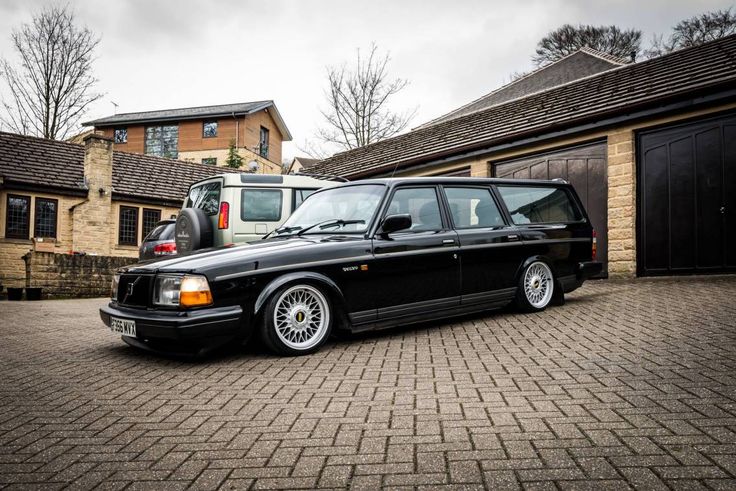 Тогда, по всей видимости, появилось желание делать то, что сейчас называется кастомом. Годы шли, велосипед сменился автомобилями, скотч — болгаркой, фонарики и прочие атрибуты превратились в пневно-линии для подвески и срезанный металл ото всюду, где он мешал большим колесам.
Тогда, по всей видимости, появилось желание делать то, что сейчас называется кастомом. Годы шли, велосипед сменился автомобилями, скотч — болгаркой, фонарики и прочие атрибуты превратились в пневно-линии для подвески и срезанный металл ото всюду, где он мешал большим колесам.
Возможно, с тем же успехом владельцы стенс-проектов могли бы прикручивать синие болты на номерные рамки и красные брызговики Sparco к жигулям, но культура стенса отличается особым отношением и подходом к автомобилям. Тем не менее, каждому позволено делать со своей машиной то, что ему кажется правильным.
Почему именно 240? Это не первая и не единственная Volvo в их семейном гараже. Помимо этой, у Коли есть С30 (тоже, разумеется, не паркетник), поэтому вопроса выбора марки не стояло. 240 потому, что это стиль. Кирпичевидный дизайн Николай назвал дизайном вне времени — и мы с ним согласны, поскольку сперва это был актуальный дизайн, потом стал классический дизайн, а потом автомобиль стал янгтаймером! Данная модель является логическим развитием модели 140, выпущенной в серию аж в далеком 1966 году.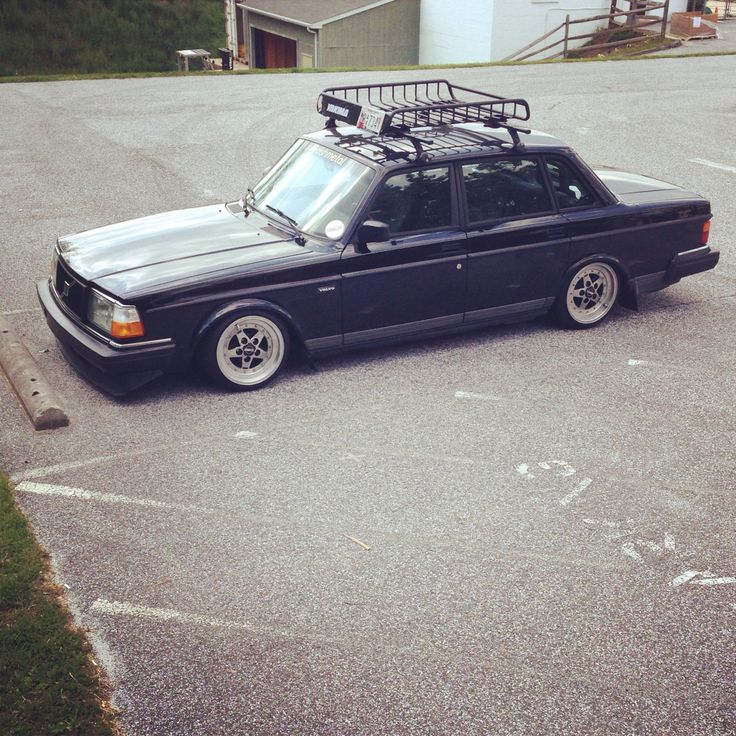 Закрытие производства 240 состоялось в 1993 — то есть, 27 лет модель выходила с одним, фактически, глубоким рестайлингом! Мы не будем ещё раз говорить о её безопасности, но в странах Скандинавии эти кузова одно время допускали до гонок даже без каркасов безопасности!
Закрытие производства 240 состоялось в 1993 — то есть, 27 лет модель выходила с одним, фактически, глубоким рестайлингом! Мы не будем ещё раз говорить о её безопасности, но в странах Скандинавии эти кузова одно время допускали до гонок даже без каркасов безопасности!
Спустя год поисков был куплен данный автомобиль: 1993 год выпуска, коробка автомат, двигатель B230F и 170 000 км пробега. Более того, до 2000 года автомобиль накатал честные 22000 км, поскольку был закреплен за дипломатом РФ в Австрии, после чего был продан дедушке, который машину любил и оберегал. Судьба, кстати, первый раз свела героя нашего материала и эту 240 на Варшавском шоссе, где он встретил этого самого дедушку и эту самую Вольво просто в потоке. Не думаю, что кто-то тогда мог предполагать подобное развитие событий.
- Volvo 240 — Impul Silhouette
Мы видели много различных ответов на вопрос о стержне проекта, но ответ Николая был наименее привычным: стержнем проекта является жена. Мало того, что сам он увлекся культурой низких шведских автомобилей, так ещё и жену вовлек! Теперь именно Евгения является основным автором изменений автомобиля, а Коля лишь периодически вносит свои идеи.
Мало того, что сам он увлекся культурой низких шведских автомобилей, так ещё и жену вовлек! Теперь именно Евгения является основным автором изменений автомобиля, а Коля лишь периодически вносит свои идеи.
Как вы уже поняли, автомобиль по-настоящему семейный. Спустя годы увлечения культурой низких автомобилей, Николай обрел не только множество настоящих друзей, разделяющих его увлечение, но и верную опору совсем рядом, которая поддерживает его во всех безумствах. Безумствах, конечно же, для других. Квартира, заваленная запчастями и дисками, бампер, живущий на балконе – не все смогут спокойно смириться с таким укладом вещей.
«Женя гнала 240-ую, раскочегарив её до 120 км/ч по дороге к Розе Хутор. Она переживала за неё в каждом повороте на серпантине. А я в тот момент переживал за них обоих, но зря. Женя отлично справляется. Тот момент вообще был неописуем : 2 человека, 1 машина, общие цели, переживания, желания — одно дело, когда машину с человеком что-то объединяет, но когда два человека объединены таким количеством эмоций друг с другом и с машиной — это что-то неописуемое.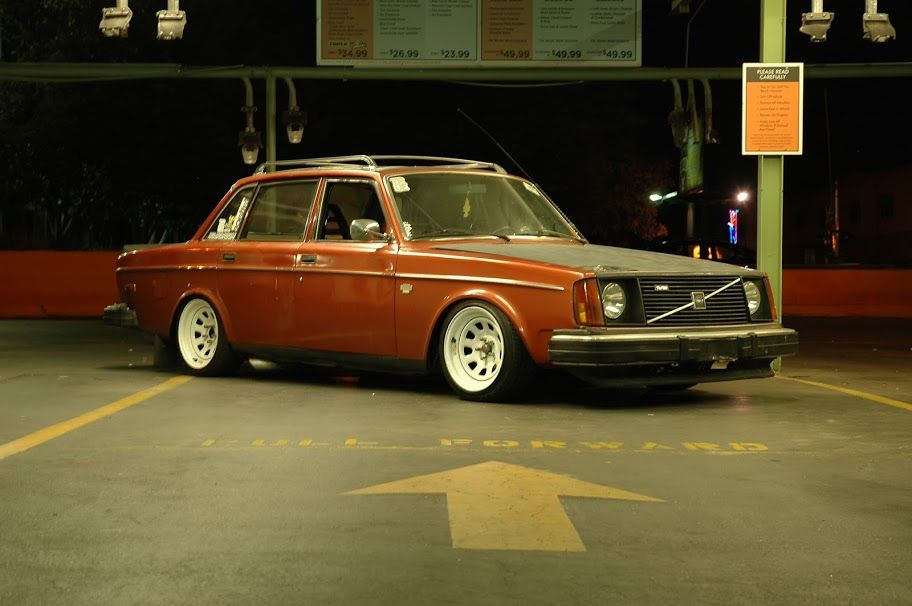
Но не женой единой… К проекту оказалось причастно великое множество людей, что говорит о дружелюбии владельцев шведской классики, но настало время перейти непосредственно к постройке авто.
Начать было решено с того, что дарит автомобилю 70% внешнего вида: с колес. Рассматривалось 2 варианта: 16” колеса от Corvette C4 (те, что выглядят как мясорубки) или 17” Impul Silhouette. Оба варианта выглядят массивно и олдскульно, плюс за счет подчеркнутой круглой формы центров отлично гармонируют с абсолютно квадратным кузовом. Остановились на Impul Silhouette, решено было строить tuked с отличной пневмоподвеской.
Пневмоподвеска была обязательным требованием. Через статику Коля прошел и поддон двигателя в С30 теперь снится ему в кошмарах, второй раз устраивать подобные экзекуции автомобилю не хотелось. Но задумка была не просто поставить пневмоподвеску, а сделать установку максимально «аналоговой» — сократить количество электронных блоков, оставить аналоговое управление и манометры в салоне. Теплая, ламповая…
Но задумка была не просто поставить пневмоподвеску, а сделать установку максимально «аналоговой» — сократить количество электронных блоков, оставить аналоговое управление и манометры в салоне. Теплая, ламповая…
Автомобиль был бережно разобран и выкрашен заново. Насчет цвета долго не размышляли – жена ещё 2 года назад решила, что это будет зеленый. А вот на подбор подходящего оттенка ушло 16 выкрасов! Зато вышло именно то, чего изначально хотели.
Не только на подбор оттенка ушло много времени – общий вид автомобиля также менялся не единожды. Молдинги переднего и заднего стекол сразу было решено поставить хромированные. Рамки дверей планировалось сделать черными, но в какой-то момент их все-таки отполировали. Зеркала напротив, должны были встать с первых серий 240 хромированные, а встали уже поздние, черные, но зато новые. Передняя часть осталась максимально современная, пусть она и не такая милая, как «ранняя», но со своим шармом. А вот на том месте, где сейчас красуется значок “Lambda Sond”, когда-то были ДХО – машина с ними была куплена, собрана и оплевана всеми, кто её видел и имел хоть сколько-нибудь авторитетное мнение.
Салон достался в почти идеальном состоянии, поэтому работ по перешиву, замене и реставрации не предвиделось. А вот до оснастить опции потребовалось: родную кассетную магнитолу 1985 года, например. В будущем году ещё планируется докупить деревянную отделку лимитированной серии Classic, другой руль и заняться оформлением багажника. Также аккуратно были вмонтированы манометры системы подачи воздуха в подвеску, причем всё установлено в заводские места под дополнительные приборы.
В этом году автомобилю не удалось много поездить, зато его удалось почти полностью закончить, если не считать нюансов. Главная задача на следующий сезон – больше получать удовольствия от движения автомобиля, а не от его нахождения в гараже.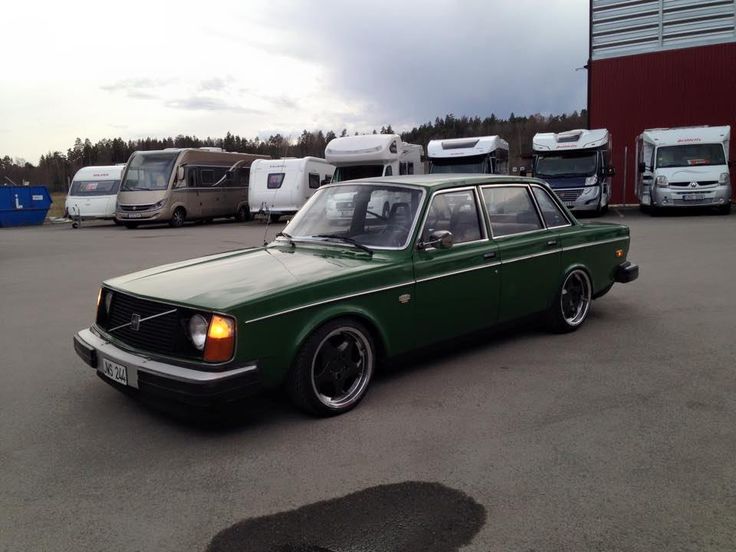 Ну и закончить мелочи по салону, разумеется.
Ну и закончить мелочи по салону, разумеется.
Что по поводу культуры в СНГ? — Качественной. Запихни в машину винты и колеса — это мало кого удивит и вряд ли вызовет интерес, это уже давно не 2011 год. Многие до сих пор надеяться на “легкий вход в культуру”, но “бобёр там плавал”. Ну и будем честны, те кто раньше просто гонял на сходки, цепляя по пути десяток лежаков , а потом мотали 600км+ на одометре по пути на “Грабли” — давно стали одной большой семьёй, друзьями, многие обзавелись семьями, детьми — тусовка взрослеет и у многих отношение ко всему происходящему меняется. Это отнюдь не плохо, ведь все мы люди — это действительно здорово. Но этот процесс подразумевает смену поколений, и сейчас культуре нужен тот самый приток, но как я сказал ранее — не простой, а качественный, как машин, так и людей.
Как мы уже говорили, есть автомобили вне времени. Глядя на эту вольво, в профиль отдаленно напоминающую жигули, хочется задаться вопросом: кто из современных, доступных большинству машин станет такой вот «классикой вне времени»? Есть ли у кого-то шансы?
На этом мы прощаемся с Николаем, его женой Евгенией и желаем им закончить все работы по 240 и просто получать удовольствие от круизинга по городу.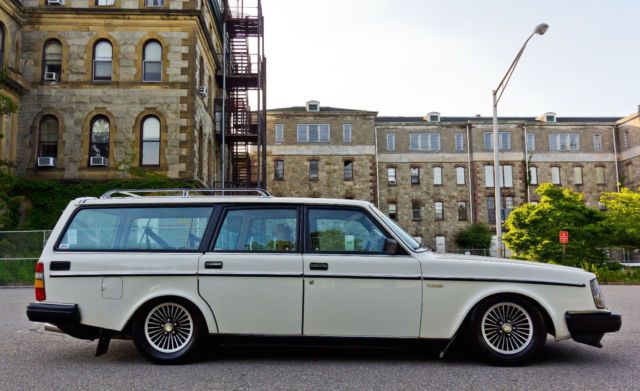
До новых встреч, друзья!
Над статьей работали:
Owner: Николай & Евгения
Photographer: Илья Шимановский, Влад Белый
Editor: Олег Соколкин
Lowdaily shop — наш официальный online магазин
VOLVO’S ESTATE CARS – a high-capacity trip down memory lane
VOLVO’S ESTATE CARS – a high-capacity trip down memory lane
At the time of its launch, there was scarcely a car in existence that was more practical than the model Volvo unveiled exactly 50 years ago, in summer 1953. Half a century and millions of estate cars later, the concept of practicality still remains the talking point of these Volvo cars.
The early 1950s saw much head-scratching at Volvo. To the surprise of the company’s two founders, the Volvo PV444 had grown into a resounding sales success. The originally planned production run of 8,000 cars was far from sufficient to meet demand, which of course was highly encouraging. But there was a major downside to the little passenger car’s modern construction: it had a chassis-less monocoque structure. This meant that the many independent bodybuilders then in existence did not have a small Volvo chassis on which to build small commercial vehicles such as vans and pick-up trucks.
But there was a major downside to the little passenger car’s modern construction: it had a chassis-less monocoque structure. This meant that the many independent bodybuilders then in existence did not have a small Volvo chassis on which to build small commercial vehicles such as vans and pick-up trucks.
Duett
To solve this problem, a chassis was designed towards the end of the 1940s that in all major respects – apart from the frame members and their cross-members – was based on the PV 444. The new frame soon acquired a good reputation and many bodybuilding firms built both pick-ups and vans based on the renamed 445 chassis. Production of the PV444 speeded up and so too did the manufacture of the small chassis. So much so that in early 1952, there were 1,000 unsold chassis in Volvo’s stocks. This was a cause of much concern, particularly for one of Volvo’s founders, economist Assar Gabrielsson. He therefore turned to engineer Erik Skoog, one of the people who had worked most intensively on the development of the PV 444.
Erik Skoog does not remember the precise wording of the request, but Gabrielsson was not exactly known as a man who wasted unnecessary time on new car models. He had already decided to build a van, so Erik simply had to get on with his drawing. Work got under way on 2 May 1952.
“I began by drawing a van, but soon realised that this would make an excellent estate car too,” recalls Erik.
He therefore made 1:5 scale drawings for two variants. Erik Skoog was an engineer, not an industrial designer or car designer. Yet his drawings were so thorough that only a few minor details were changed during the model’s lifetime, apart from the windscreen which was later modernised.
On 4 July 1953, the first fully Volvo-built PV445 was ready for delivery and that first customer was none other than Assar Gabrielsson. The car was designated 445 DH and it was an estate car, in other words with an airy, bright interior. On 20 November, the first van version was ready, designated the Volvo PV 445 DS.
Version three did not arrive until 19 July 1955, and it was a somewhat more comfortably appointed estate car. Its model designation was PV 445 PH, with the last two letters indicating in Swedish that this was a passenger-carrying estate car. With these three versions, the Duett series was now complete.
The Volvo Duett was not a large car, but it swallowed unbelievable amounts of luggage – thanks in no mean part to the body’s upright sides and the generous roof height in the luggage compartment. The floor’s raised metal pressings were originally intended to carry the load, but even the very first cars featured elegantly varnished wooden slats attached to the floor pressings to allow the load to slide conveniently and smoothly into the car. In all other respects, the interior trim matched that of the passenger car model.
The first model years used the Volvo 444 B4B engine, a 1.4 litre unit producing 44 bhp. In 1957, displacement rose to 1.6 litres and power was upped to 60bhp, and this B16 engine gave the Duett a welcome increase in power and torque.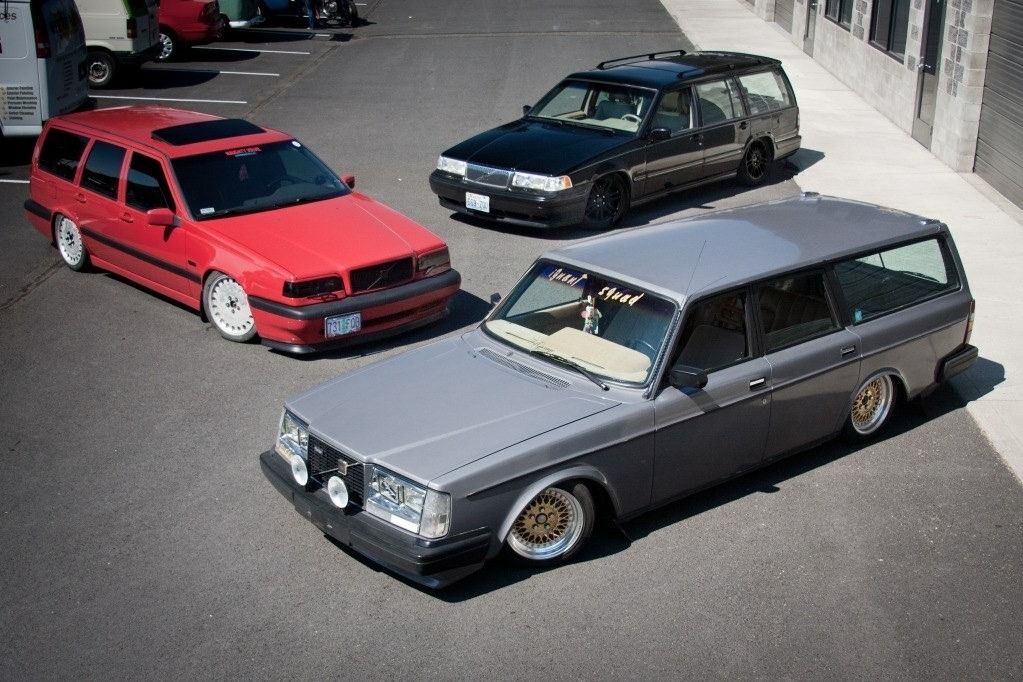 Apart from having the car delivered in primer, customers had just three topcoats to choose between: red/beige, livery blue/beige and grey/beige.
Apart from having the car delivered in primer, customers had just three topcoats to choose between: red/beige, livery blue/beige and grey/beige.
In the mid-fifties, Volvo launched a marketing offensive in the large and attractive US market. The company hoped for export success for the Duett too and in the English-language brochures, it still retained its original name of Duett, but now with just one ‘t’ – Duet. The name, irrespective of the language in which it was written, prompted the perception of this model as “two cars in one” – a car that united practicality with pleasure and allowed dual use at both work and free time.
For 1958, a number of minor exterior changes were made to the Duett, for instance with the oval tail lamps being replaced by rectangular units. The PV passenger-car model got a new one-piece windscreen at this time, but Duett customers had to wait another two years for this new-fangled innovation. In the meantime, they could console themselves with modern instruments, seat belts as standard and a four-speed gearbox.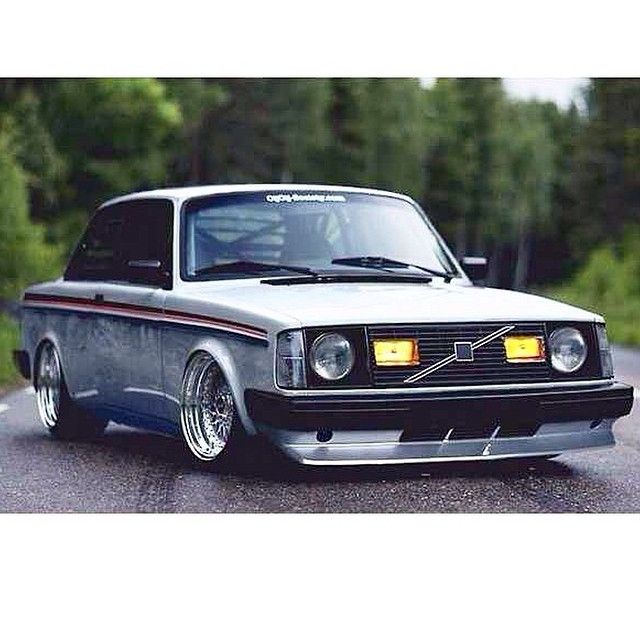
In 1960, the Duett name was dropped and the model was known instead as the P210. It was available in two versions – as a van or estate car. And that is how the range remained for the rest of the model’s career. 1962 saw the introduction of the B18 engine in Volvo’s little work-horse. 75 horsepower – that was almost twice as much as the model had had upon its introduction!
Even though the Duett was no longer called the Duett, it still remained very popular indeed. However, when the Volvo Amazon was made available as an estate car, most people felt the Duett’s days were reckoned. Little did they know! The model’s best-ever sales were recorded in model year 1961, when no less than 11,744 customers signed on the dotted line. For the rest of its life, the P210 sold a steady 7,000 or so a year – despite the availability of the far more modern and advanced Amazon estate car.
The very last Duett – or P210 if we are to be strictly accurate – was built on 19 February 1969. This dark-blue vehicle was driven straight to Volvo’s historic-car collection, where it still has pride of place with just over 100 km on the odometer. All told, 97,298 Volvo Duett/P210 cars were sold. This figure also includes the 2,915 so-called delivery chassis that were sold between 1949 and 1953.
This dark-blue vehicle was driven straight to Volvo’s historic-car collection, where it still has pride of place with just over 100 km on the odometer. All told, 97,298 Volvo Duett/P210 cars were sold. This figure also includes the 2,915 so-called delivery chassis that were sold between 1949 and 1953.
P220/Amazon
The estate car was the third version of the Volvo Amazon. It was unveiled at the Stockholm Motor Show in spring 1962 and it was completely different in nature to the Duett. Its combination of comfort and load-carrying capacity was remarkable, as were several of its elegant innovations and solutions. In true American fashion, the tailgate was a two-piece unit with the glass window opening upwards and the lower metal panel dropping down. Perfect for lugging long planks of wood for those most Swedish of pastimes – home extensions in town or log-cabin building in the country. And when the time came to hoist loads onto the roof, it was convenience itself to stand on the rear bumper’s flat, rubber-topped over-riders.
Out on the road, the Amazon estate car behaved pretty much like the two-door or four-door sedan models since there was little difference in weight. The chassis designs, however, were different at the rear. This was because the load compartment floor had been lowered in the estate car to create the required load volume. The rear section therefore had a sturdy box-section beam structure. The rear-facing support arms were reinforced and the coil springs were supplemented with auxiliary springs. The Amazon estate car was type-approved to carry a load of 490 kilograms.
The load compartment measured 183 cm in length and 126 cm across – sufficient to accommodate most standard-size wall panels!
Volvo had been focusing actively on car safety ever since the mid-fifties. As of 1959, all Volvo cars were delivered with front three-point seat belts, making Volvo the first car maker in the world to include this feature as standard. The estate car started its career powered by the B18A engine, which was not a further development of the B16 but an entirely newly designed, five-main-bearing engine producing 75 horsepower. A four-speed manual gearbox was fitted as standard.
A four-speed manual gearbox was fitted as standard.
The 1964 Amazon received a welcome upgrade in the form of front disc brakes. The estate car also got a brake servo and a small but highly welcome feature: a gas-filled spring strut for the upper half of the tailgate.
Even more important that this spring, however, were the entirely new front seats. For the first time, the concept of ergonomics could be done true justice even though the word itself would not come into fashion for a good many years to come. The seats were developed in cooperation with medical experts and consisted of thick cushions of polyester foam which offered damping motion against sturdy rubber straps. The padding was harder at the edges, giving excellent support in fast curves.
The Volvo Amazon was built until 1969, both as a passenger car under the designations P121 and P122, and as an estate car, the P220. A total of 73,000 estate versions rolled out of the Torslanda factory gates during the model’s lifetime.
145
By the mid-sixties, Volvo was an established manufacturer of estate cars. Summer 1966 saw the launch of the Amazon’s successor, and it was Volvo’s first model with a new numerical designation. It was called the 144, and it relied largely on the tried and tested technology that had done such sterling service in the Amazon. The rear suspension was a further development of that found in the estate car.
The new car put the spotlight well and truly on safety. A welded, very torsionally rigid all-steel body formed the basis, and both the front and the rear were engineered as energy-absorbing crumple zones designed to deform in a crash. At least equally important was the braking system, which was now of triangular split dual-circuit type with disc brakes all round.
With such a robust base, the estate car version could scarcely be anything other than a resounding success. It arrived in 1967, and with a nod to logic it was named the 145 (series 1, 4-cylinder engine, 5 doors).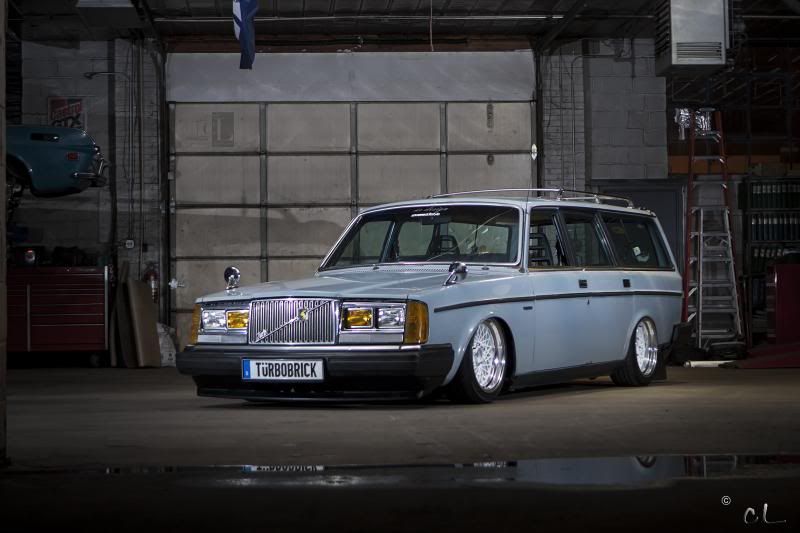 It was technically identical to the four-door sedan apart from the reinforced rear suspension which was bolstered to handle heavy loads.
It was technically identical to the four-door sedan apart from the reinforced rear suspension which was bolstered to handle heavy loads.
The load space was impressive, and nobody was surprised over how quickly sales got off the ground and how steady they remained. The reason was that the Volvo 145 was not just a car that could handle large loads, it was also a stylish conveyance. It may not have had the most thrilling or exciting of designs, but its lines were harmonious, understated and timeless. Which may explain why there are still thousands of 145s on roads the world over.
Volvo was now beginning to be regarded far and wide as primarily a maker of estate cars. On certain markets, there was something of a cult surrounding the exotic “truck” from Schweden, Sweden, la Suède, Svezia or whatever. This cult was further nurtured when the last of the 270,000 Volvo 145 models left the factory in 1974 and the range was replaced by the Volvo 245.
245
It is probably no exaggeration to say that the 245 will never win prizes for the most attractive car ever produced by Volvo, but it certainly was safer than just about anything else on four wheels, and in true Volvo style it swallowed prodigious loads.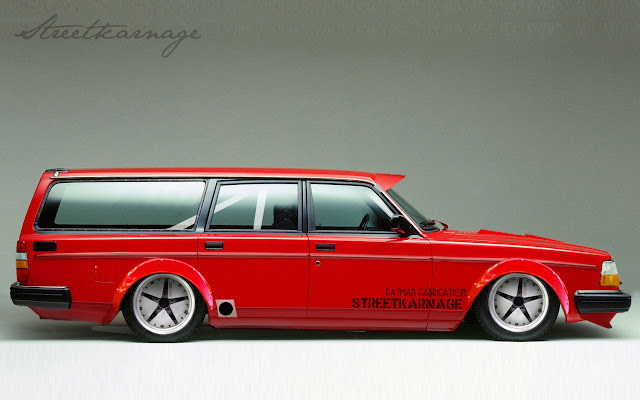
In the Volvo 245, the engineers had built in even more safety than ever before. The fuel tank, for instance, was installed ahead of the rear axle and the steering column was a collapsible unit which would not penetrate into the passenger compartment even in a violent frontal collision. Volvo’s safety work was now so intensive and so successful that the 240 Series was selected as the norm car by the American NHTSA, the National Highway Traffic Safety Administration.
According to the rule-book, the 245 should have lasted a bit into the early 1980s, but this estate car showed itself to be made of sterner stuff. Neither circumstances nor age succeeded in ending this model’s production run until 1993. In fact, even as late in its life as 1991 – just two years before the model was superseded – the American Insurance Institute for Highway Safety noted that the Volvo 240 was the safest car on the US market.
The Volvo 245 was launched together with the 244 and 242 and was followed a year later by the more upmarket six-cylinder 265 models. All in all, Volvo would build almost one million of these load-luggers.
All in all, Volvo would build almost one million of these load-luggers.
760 and 740
All Volvo’s estate cars thus far hade featured rear-wheel drive. So too did the new model series which made its debut in 1982 in the form of the Volvo 760 GLE. This model grew into a whole range of versions, among them the 745 – yet another estate car classic in the making.
The Volvo 745 estate car was introduced on Volvo’s largest single market in 1985, when the wraps were pulled off it at the Chicago Motor Show in the USA. In principle, the rear of the car was all that set it apart from the corresponding 740 sedan model. This meant that equipment and comfort levels had risen compared with the 245 it replaced, for instance with the entire load compartment featuring neat and practical textile trim. Extra care was also paid to sound insulation, which added further to comfort, and since the rear seat backrest could split-fold, the load compartment offered hitherto unparalleled flexibility.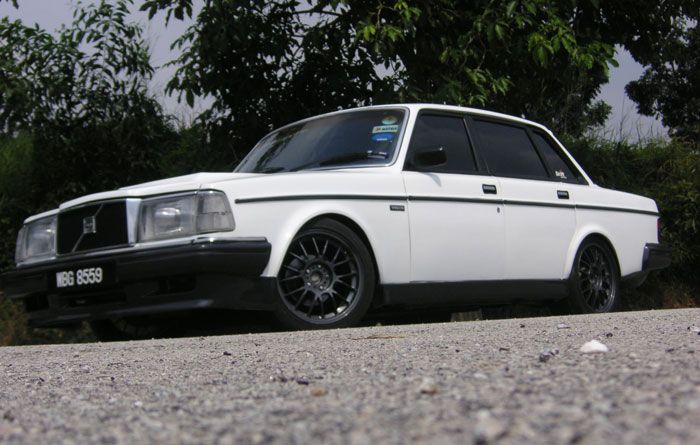
Thanks largely to the relatively boxy shape of the rear bodywork – something that the 745 shared with all its predecessors – it could swallow 992 litres of luggage with the rear backrest in the upright position, growing to 2,123 litres with the seat folded.
The Volvo 745 was sold only in the US in its first year of production, followed thereafter by the model’s triumphant entry into the European market. Car buyers’ requirements and expectations had been growing all the time, so demand focused more on the better-equipped and more powerful versions. The Volvo 740 Turbo estate car was one of the fastest five-door cars of its time. It shot to 100 kilometres an hour in just 8.5 seconds, propelled by no less than 200 horsepower.
Some things didn’t grow, however: both the 240 and the 740/760 Series were very easy to handle thanks to their excellent turning circle of just 9.9 metres.
With its 740 and 760 models, Volvo advanced into the so-called upper middle class of cars.
In 1990, an entirely new generation of cars was launched, the 900 Series, a further developed and improved version of the 700 Series. From the outside, the 900 could be distinguished by its somewhat smoother, more rounded lines and more modern headlamps.
Just as the 700 Series had been available as the 740 and 760, so too was the new model available in 940 and 960 form. What was interesting was that the cheaper 940 had to make do with a live rear axle whereas the high-specification 960 version featured a multilink rear axle.
And all large Volvo cars were still rear-wheel drive. Or were they?
850
The short answer is no, they were not, because already in summer 1991 Volvo had presented an entirely new model series. It was known as the 850 and it integrated a number of remarkable new features in its design. The Volvo 850 had front-wheel drive and the engine was installed transversely. These cars were powered by an entirely new generation of five-cylinder engines featuring twin overhead camshafts and four valves per cylinder.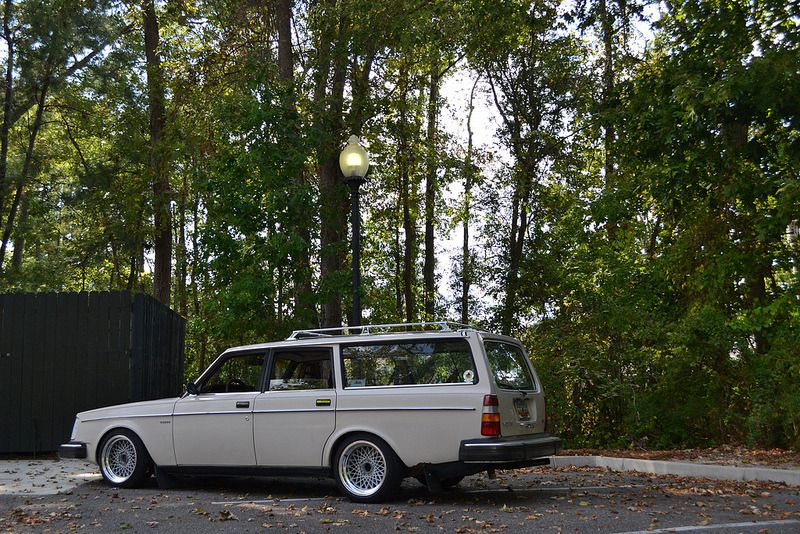 The first 2.5 litre version had 170 horsepower and when the 850 Turbo in T5-R guise hit the streets with its 240 horsepower, Volvo had for the first time in its history a car that topped 250 kilometres an hour. This impressive top speed did wonders for Volvo’s image, primarily on the non-restricted German autobahn, but equally important was the new Deltalink rear axle.
The first 2.5 litre version had 170 horsepower and when the 850 Turbo in T5-R guise hit the streets with its 240 horsepower, Volvo had for the first time in its history a car that topped 250 kilometres an hour. This impressive top speed did wonders for Volvo’s image, primarily on the non-restricted German autobahn, but equally important was the new Deltalink rear axle.
On certain markets, estate cars accounted for more than 60 percent of Volvo’s sales. A truly successful 850 estate car was therefore crucial – and it arrived, but not before early 1993.
The 850 estate car may not have been as spacious as the 945, but it was remarkably flexible and it integrated a wealth of intelligent details. For example, a pull-out two-part load net, rear head restraints that did not need to be removed when folding the rear backrest, and naturally also a three-point seat belt in the rear middle seat. What may have aroused the greatest attention at the car’s launch were the long vertical tail lamps that followed the rear pillars almost all the way to the roof.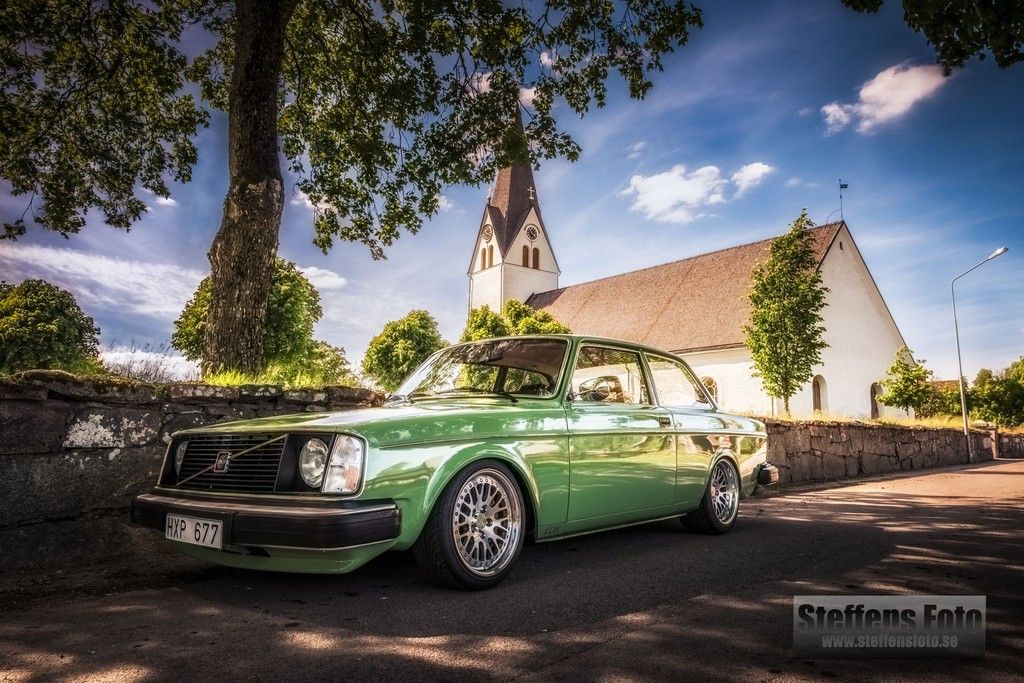
The Volvo 850 GL/SE/GLT in estate car guise received an enthusiastic welcome and virtually sold itself.
And it also reaped awards and accolades. In its first three years, the 850 Series received more than 50 awards. Many of them were for the car’s design and its ride and roadholding properties, and even more for its built-in safety, for example in the form of side-acting airbags and inflatable curtains.
The estate car received a great deal of exposure from an unusual source when Swedish auto-racing ace Rickard Rydell drove one to some rather impressive finishes in the British Touring Car Championship (BTCC).
Production of the Volvo 850 estate car totalled 326,100 between 1992 and 1997.
V40
Right at the very start of 1996, an entirely new model was introduced in Sweden, a product of the cooperation between Volvo and Mitsubishi at the jointly owned factory in Born in the Netherlands. The car was a four-door sedan called the S40, and just a few months later this was followed by an estate car version, the V40.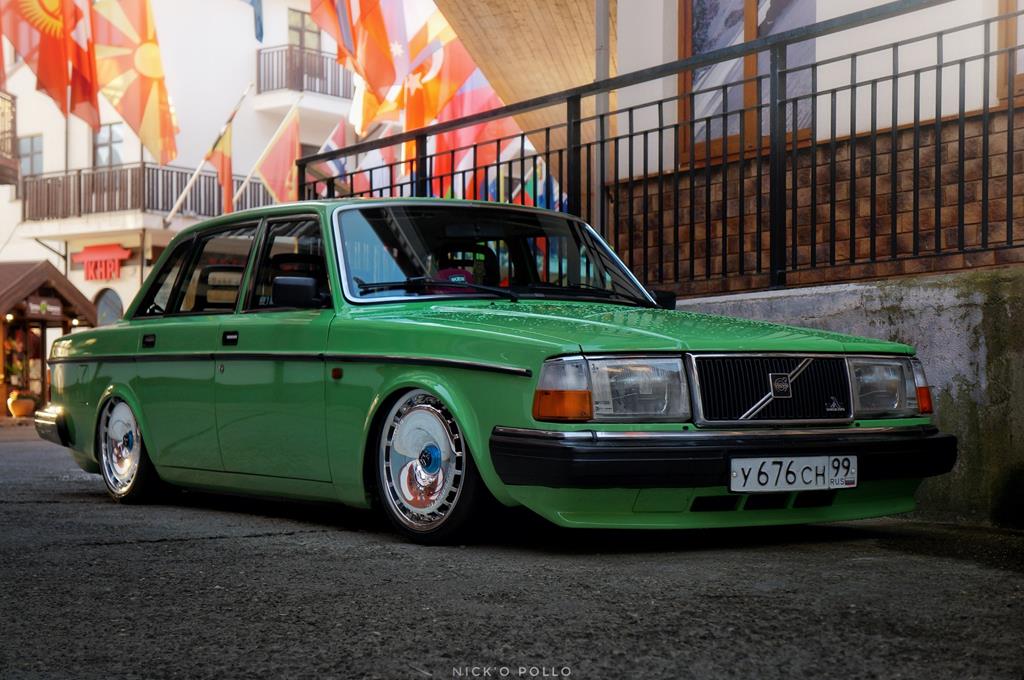 These compact and attractive cars were powered by engines of 1.8 or 2.0 litres, and true to Volvo custom, safety was elevated to new heights in both models. The S40/V40 had side-mounted airbags, a feature that no other car in this class had ever had before. This was followed a little later by the WHIPS whiplash protection system and the SIPS side-impact protection system.
These compact and attractive cars were powered by engines of 1.8 or 2.0 litres, and true to Volvo custom, safety was elevated to new heights in both models. The S40/V40 had side-mounted airbags, a feature that no other car in this class had ever had before. This was followed a little later by the WHIPS whiplash protection system and the SIPS side-impact protection system.
The V40 was a compact car and thus not as spacious as the 850, for instance, but that did not prevent junior from receiving an impressive number of prizes and awards of its own, too.
With the S40/V40, Volvo introduced a new model designation system. S stands for Sedan and V for Versatility, that is to say flexibility. Autumn 2003 will see the launch of the first model in an entirely new generation of cars to succeed the current S40/V40. To date, Volvo has built about 500,000 of the current V40 model.
V70
In November 1996, Volvo presented a further development of the 850 estate car.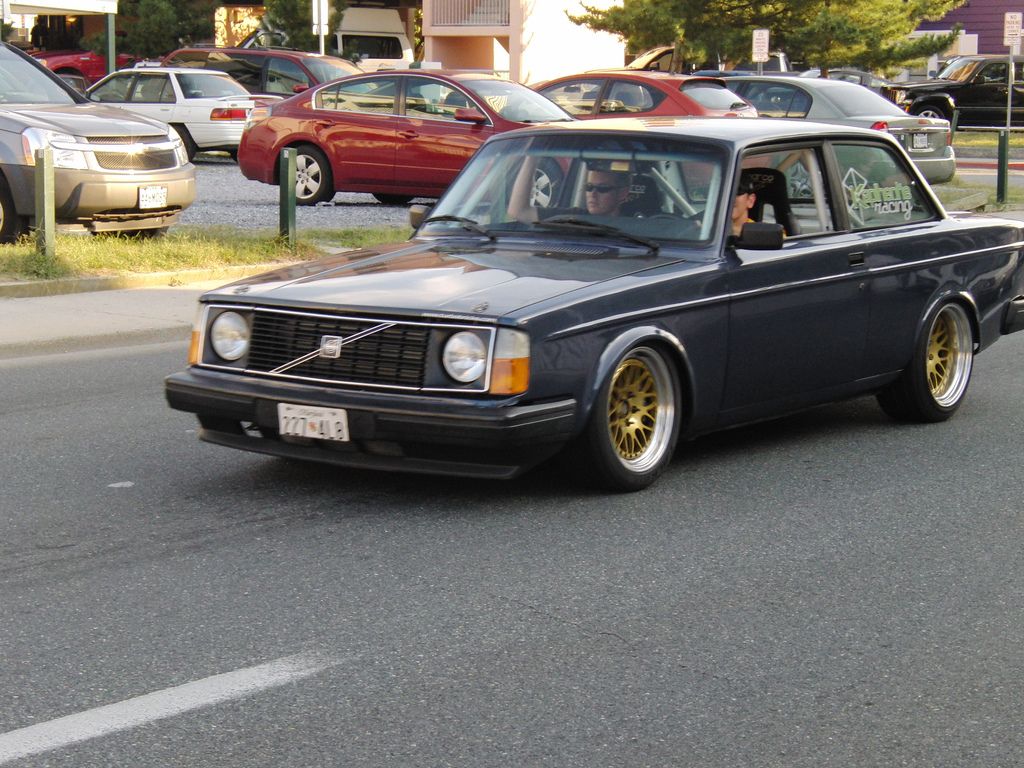 It was called the V70 and it had a more aerodynamically efficient front. The exterior panels were somewhat more rounded and the interior was entirely new. The rejuvenation process involved about 1,800 new parts, so it was far more than a cosmetic face-lift. From 1997, the V70 was available in Bi-Fuel configuration, with the four-wheel drive Volvo V70 Cross Country being launched at the same time.
It was called the V70 and it had a more aerodynamically efficient front. The exterior panels were somewhat more rounded and the interior was entirely new. The rejuvenation process involved about 1,800 new parts, so it was far more than a cosmetic face-lift. From 1997, the V70 was available in Bi-Fuel configuration, with the four-wheel drive Volvo V70 Cross Country being launched at the same time.
From 1996 to 2000, about 320,000 examples of this first V70 series were built. To this can be added another 54,000 Cross Country models.
With the launch of the all-new Volvo V70 in January 2000, Volvo’s design chief Peter Horbury had penned a completely new design language. Powerful lines with a hungry front and pronounced haunches along with virtually concave body sides gave the V70 an appearance that was as different as it was elegant. The car was unveiled simultaneously at the Detroit and Brussels motor shows.
It received a rapturous welcome, and once again Volvo had produced an estate car with style, impressive technical solutions and even greater safety. The V-shape of the bonnet can be traced back to the Duett, and it was after all there that Volvo began its career as a manufacturer of practical, durable and safe estate cars.
The V-shape of the bonnet can be traced back to the Duett, and it was after all there that Volvo began its career as a manufacturer of practical, durable and safe estate cars.
The V70 too was developed into a V70 XC Cross Country, now with an appearance that far more clearly signalled its tough attributes – a design approach that the market was not long in copying. Sales records show the model’s continued popularity. Figures thus far show more than 100,000 sales of the model which since 2002 goes under the name of Volvo XC70.
Today
Volvo’s latest addition in the segment for practical, spacious cars is the XC90, which was first revealed at the Detroit Motor Show in 2002. With the XC90, Volvo Cars powered straight into a new world: even though the XC90 is characterised as Volvo’s interpretation of an SUV, it is just as much a practical estate car as all its predecessors were. But there is a crucial difference: it has the ability to transport up to seven people in considerable comfort and with immense safety on fast highways and crowded city streets – and to continue driving even when the road ends.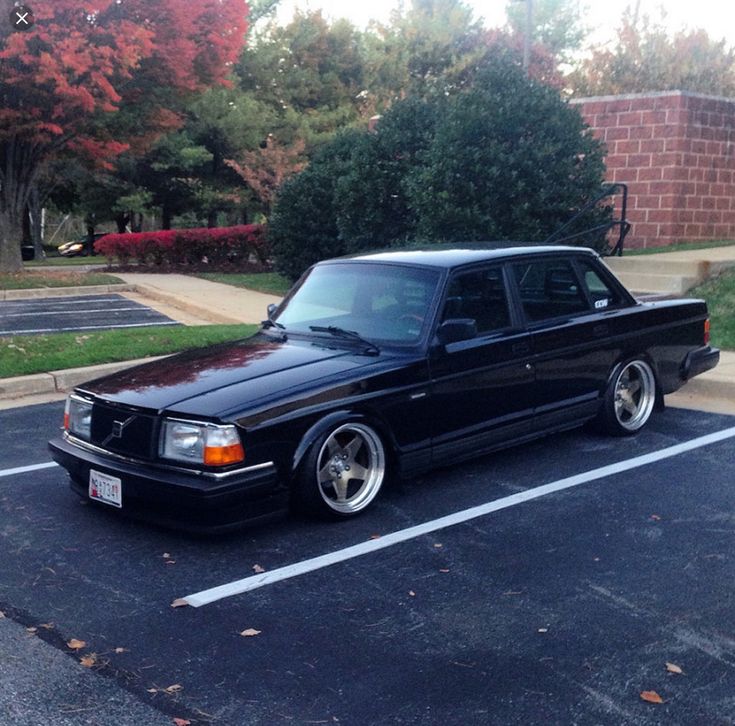
And that’s something that couldn’t be managed by the ancestor that started it all, the Volvo Duett.
At the time of writing, almost four million Volvo estate cars have been manufactured and sold the world over. Few if any car makes are as strongly linked with this type of car as Volvo is. And although the Duett was far from the first estate car on the market when it was launched in 1953, it was an unusually capable car that was characterised by the very same properties that have been passed down the generations, refined and extended every step of the way. And that’s how it’s going to remain for a long time to come.
50210/PH-CR
Опубликованная в данном пресс-релизе и на медиа сайте Volvo Cars информация может быть изменена в любое время без предварительного уведомления или обязательств. Пожалуйста, для получения наиболее свежей и достоверной для российского рынка информации обращайтесь в пресс-службу Volvo Cars в России.
Йохан строит свой Volvo 240 XC до идеального совершенства
Volvo 240 является подходящей базой для проектного автомобиля, и Volvo 240 XC Йохана доказывает это. Это уникальная постройка уникального человека. Йохан не делает вещи простым путем, он строит свои собственные детали. Он изготавливает все, что ему нужно, чтобы создать машину именно такой, какой он хочет. Никаких компромиссов, и нам это нравится.
Это уникальная постройка уникального человека. Йохан не делает вещи простым путем, он строит свои собственные детали. Он изготавливает все, что ему нужно, чтобы создать машину именно такой, какой он хочет. Никаких компромиссов, и нам это нравится.
‘Ну да, иногда что-то идет не так. Я люблю ломать вещи. Йохан рассказывает историю с ухмылкой на лице; «Помню, однажды я чуть не потерял переднее колесо. Я проехал через кювет на скорости чуть выше средней. Одно переднее колесо застряло в брандмауэре. Так что я стоял там, в поле, с машиной, не в силах двигаться, потому что не мог ехать вперед. Но потом я узнал, что при движении назад колесо откручивалось примерно на полсантиметра, как раз достаточно, чтобы доехать до дома. Но мне пришлось проехать десять километров задним ходом, чтобы добраться туда. Так что я ехал очень медленно с перегретым двигателем, потому что ему не хватало охлаждения при движении назад. Люди в моей деревне смотрели на меня как на сумасшедшего, почему он едет задом? И колесо сильно дымило от трения о переднее крыло.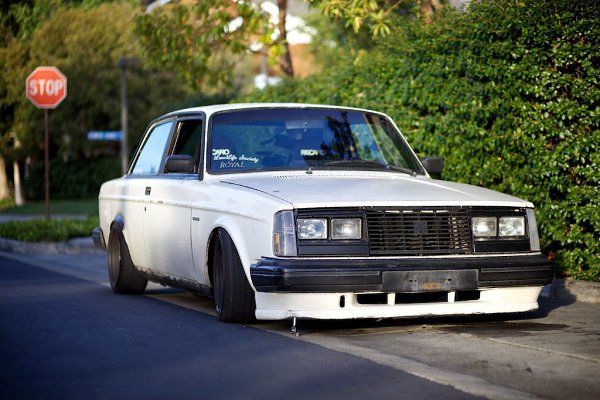 Да, я думаю, люди в моем маленьком городке знают, кто я. И что я делаю.
Да, я думаю, люди в моем маленьком городке знают, кто я. И что я делаю.
Это своего рода пример для человека, у которого мы сегодня берем интервью. Йохан живет в типичном рабочем районе тихого городка на юге Нидерландов. Его улица состоит из скромных домов и унылых семейных автомобилей. На самом деле, как когда-то была его машина, потому что давайте будем честными: Volvo 240 не был воплощением чувственного автомобильного дизайна. Некоторые люди до сих пор думают, что он был разработан с использованием в общей сложности двух кирпичиков Lego.
Но этот Volvo 240 немного изменился. Возможно, это все еще не сексуально, но уж точно нельзя обвинить в скучности. Он желтоватый с черными акцентами, и он выделяется и другими способами. «По образованию я дизайнер. В детстве я всегда мечтал что-то конструировать. Я использую свое творчество и делаю людей счастливыми». У него немного изменен дорожный просвет, и, в отличие от следующего проекта, скрывающегося на его заднем дворе, дорожный просвет не был изменен в сторону асфальта.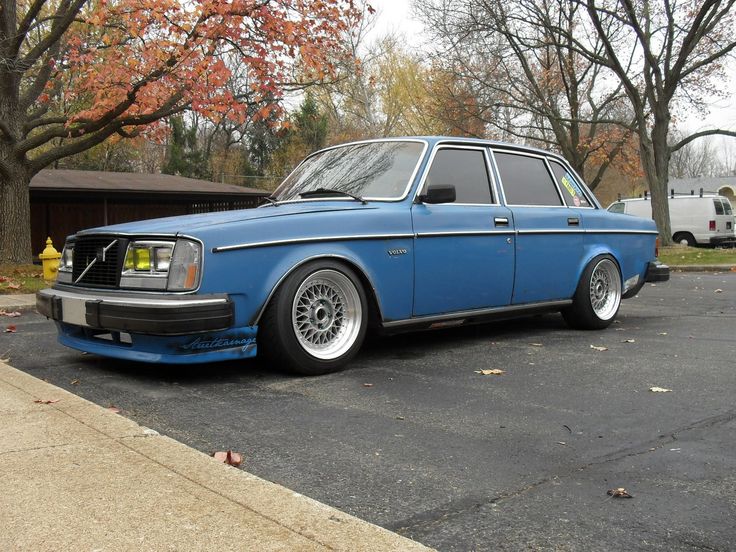
Нет, этот автомобиль был создан, чтобы передвигаться по вещам, держать его как можно выше над землей. Это должен был быть старый Volvo, потому что Йохан питает особую любовь к старому заднеприводному Volvo за его квадратность и простоту.
Йохан работает в офисе веб-разработчиком, что в наше время означает, что он в основном работает из дома. Но когда офисная работа заканчивается в пять часов, надевается комбинезон, и Йохан проходит пять метров от своего стола, чтобы войти в свой гараж. Или то, что раньше было его гаражом, потому что теперь у него там полноценная мастерская по металлу. Компактная человеческая пещера, заполненная всевозможными механизмами для «создания вещей», которые готовит его удивительный ум.
Врезался Volvo 240, который медленно готовится встать рядом с поднятым автомобилем на подъездной дорожке. Йохан захлопнул Volvo, когда возникла идея поднять 240. Увидел фото поднятого Вольво и вдохновился. Сначала он начал просматривать Интернет в поисках идей и вдохновения.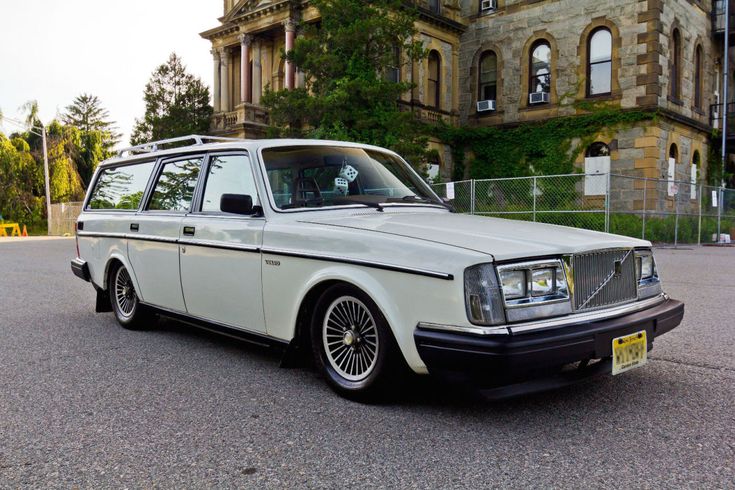 В США были люди, которые создавали поднятые 240-е, но он не мог найти подходящее оборудование для своей сборки, поэтому начал разрабатывать детали сам.
В США были люди, которые создавали поднятые 240-е, но он не мог найти подходящее оборудование для своей сборки, поэтому начал разрабатывать детали сам.
И не только лифт-комплект. Закончив базовое упражнение, Йохан продолжил. Подвеска поднимает автомобиль на три дюйма спереди и на 4 дюйма сзади по сравнению со стандартной. Но в сочетании с вездеходными колесами и шинами Йохан оценивает общий подъем примерно в 8 дюймов (20 сантиметров). Кстати, подъем машины имеет больше преимуществ: «Мне не нужно поднимать ее каждый раз, когда я что-то ломаю, я могу просто залезть под нее».
Йохан также начал добавлять некоторые личные штрихи, например, покраску покрывала Raptorliner, а также мелкие детали, такие как логотипы и другие пасхальные яйца. Вокруг этого удивительного проекта можно найти множество нестандартных мелочей.
Йохан потратил много времени на улучшение управляемости своего Volvo 240 XC. Многие из этих деталей связаны с настройкой подвески и ходовой части, в основном придуманной для улучшения управляемости с течением времени.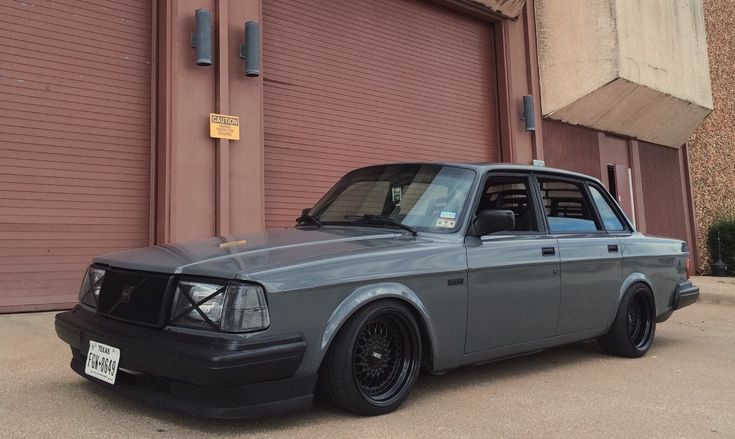 Но у него также есть специальный багажник на крыше со светодиодными полосами, например, который Йохан планирует вскоре продавать в модульной форме. Также есть кастомный задний бампер, небольшая лестница и запасное колесо сзади автомобиля. И есть прочная защитная пластина для защиты жизненно важных органов 240-го, когда Йохан решит разбить его через поле или что-то в этом роде.
Но у него также есть специальный багажник на крыше со светодиодными полосами, например, который Йохан планирует вскоре продавать в модульной форме. Также есть кастомный задний бампер, небольшая лестница и запасное колесо сзади автомобиля. И есть прочная защитная пластина для защиты жизненно важных органов 240-го, когда Йохан решит разбить его через поле или что-то в этом роде.
И дело не только в металлоконструкциях. Например: в интерьере (обновленном до кожи) есть небольшие штрихи Lego, а на рулевом колесе есть кнопка клаксона-трансформера. Везде есть детали, и чем дольше вы смотрите на эту машину, тем больше вы найдете. Он явно не создан для красоты, но, тем не менее, его эстетика приятна.
Подробная информация о Volvo 240 XC Йохана Многие спрашивают Йохана, есть ли у автомобиля трансмиссия 4×4. Ответ – нет. «Возможно сделать Volvo 240 с колесной формулой 4×4, но в основном это делается путем замены кузова. Люди берут шасси Range Rover или что-то в этом роде, а сверху кладут кузов Volvo 240.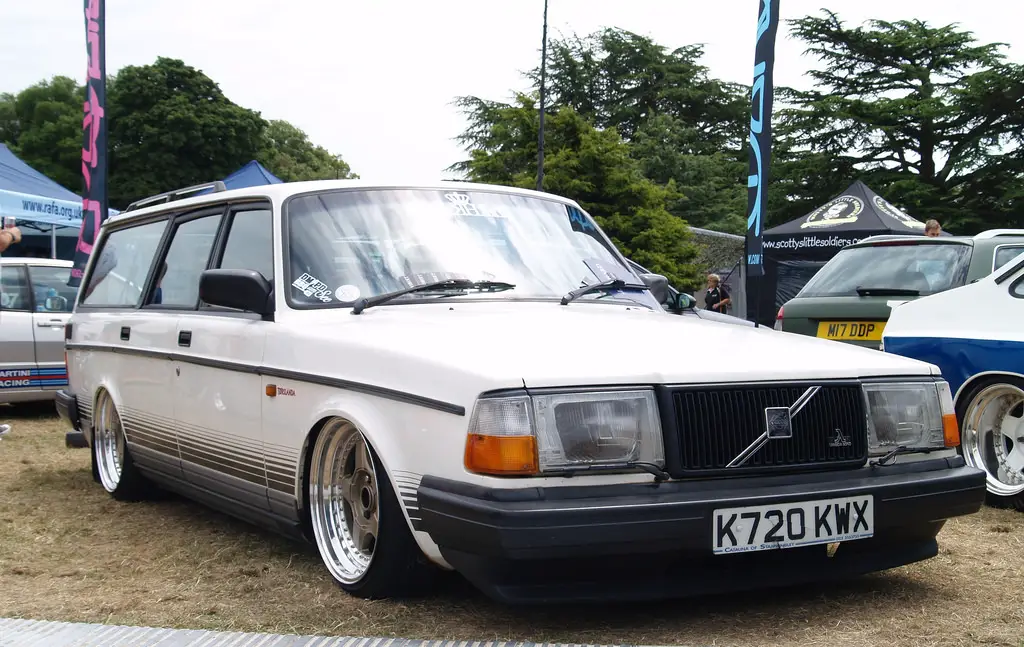 Для меня это немного обман. Если я решу сделать 4×4, я попытаюсь сделать это с оригинальными компонентами автомобиля. Для этого мне пришлось бы добавить раздаточную коробку, а что нет, что на данный момент является слишком большим проектом и почти невыполнимо с тем количеством времени и пространства, которые у меня есть здесь, дома».
Для меня это немного обман. Если я решу сделать 4×4, я попытаюсь сделать это с оригинальными компонентами автомобиля. Для этого мне пришлось бы добавить раздаточную коробку, а что нет, что на данный момент является слишком большим проектом и почти невыполнимо с тем количеством времени и пространства, которые у меня есть здесь, дома».
По этой же причине Йохан не построил его как гусеничный гусеничный трактор. «Вам понадобится 4×4 для ползания по камням. Я добавил дифференциал повышенного трения, чтобы иметь наилучшее сцепление с задними колесами, но передние колеса не ведущие. Мой девиз — просто прыгай, держи скорость, не останавливайся, потому что, если ты держишь скорость, ты сможешь пройти почти через любую местность».
Йохан выходит из своего Volvo 240 XC Нам нравится, когда автомобиль показывает личность своего владельца. Именно этим и занимается Volvo 240 XC Йохана. Он точно не робкий, он знает, что привлечет внимание. Это немного грубо по краям, но в то же время дружелюбно. Он не совершенен, но совершенен в своем несовершенстве, если вы спросите нас. Настоящий персонаж, настоящий, как и его владелец.
Он не совершенен, но совершенен в своем несовершенстве, если вы спросите нас. Настоящий персонаж, настоящий, как и его владелец.
Йохан поделился своей машиной со всем миром через интернет. Люди начали спрашивать его, могут ли они купить детали, которые он сделал для своей машины. Поэтому Йохан начал их продавать. Нам не может не нравиться название малого бизнеса, который он создал для продажи запчастей: Bad Decision Works. «Люди могут считать то, что я делал, плохими решениями, но именно эти плохие решения принесли мне мою собственную компанию, но, возможно, больше всего, эти решения принесли мне много друзей. Люди, которых я бы никогда не узнал, если бы не построил эту машину. Я дорожу всеми людьми, и общение с другими автолюбителями привело меня к этому автомобилю. Они бесценны, так что можно сказать, что плохие решения приводят к хорошим результатам».
А машина? «Проектные автомобили никогда не заканчиваются.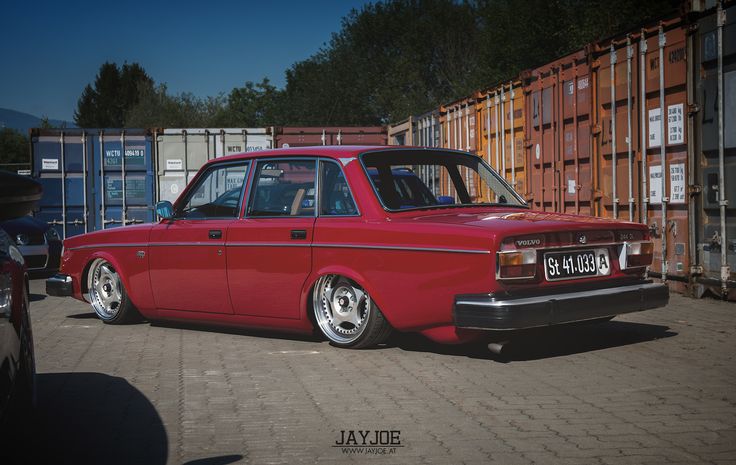 Я буду работать над этим еще несколько лет. Обычно я не держу машины надолго, но я думаю, что эта машина станет рекордсменом».
Я буду работать над этим еще несколько лет. Обычно я не держу машины надолго, но я думаю, что эта машина станет рекордсменом».
О DrivePact x Roadr
Возможно, вы заметили в этом видео водительские перчатки, которые носит Йохан. Круто, правда? Их производит небольшая компания в Нидерландах под названием Roadr, которая продает кожаные перчатки ручной работы. Как и мы, они в первую очередь настоящие любители вождения! Водительские перчатки, которые носит Йохан, называются 9.0039 Ночной водитель но есть разные типы, размеры и цвета . Итак, если вы увидели эти перчатки и подумали: «Мне они нужны!», перейдите по ссылке ниже.
Дорожный транспорт | Кожаные водительские перчатки ручной работы
Высококачественные кожаные водительские перчатки.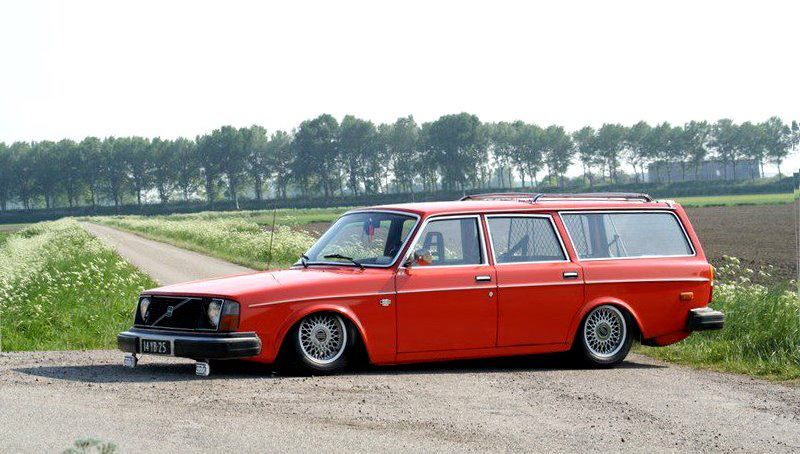 Сделано вручную и вдохновлено классическими гонками. Большая забота о деталях. Водительские перчатки для уникальных ощущений от вождения.
Сделано вручную и вдохновлено классическими гонками. Большая забота о деталях. Водительские перчатки для уникальных ощущений от вождения.
Roadr
Видео: Roadr / Hessel Sytema
Фото: DrivePact / Casper Heij
Продажа койловеров Volvo 240 Wagon 5spd turbo 300horsepwer slammed: фото, характеристики, описание
Цена: – Местонахождение товара: Портленд, штат Орегон, США
- Состояние: б/у
- Марка: Volvo
- Модель: 240
- Подмодель: 245
- Тип: фургон
- Комплектация: турбо
- Год:1985
- Пробег:307 000
- Вин: YV1AX8850F1622903
- Цвет: белый
- Объем двигателя: b23ft
- Количество цилиндров:4
- Варианты питания: Power Locks, Power Windows
- Топливо: бензин
- Трансмиссия: механическая
- Тип привода: РВД
- Цвет салона: Черный
- Опции: Кожаные сиденья
- Название автомобиля: Очистить Хочу купить? Связаться с продавцом!
Описание:
Я собирал этот автомобиль со склада в течение 5 лет, но пришло время двигаться дальше.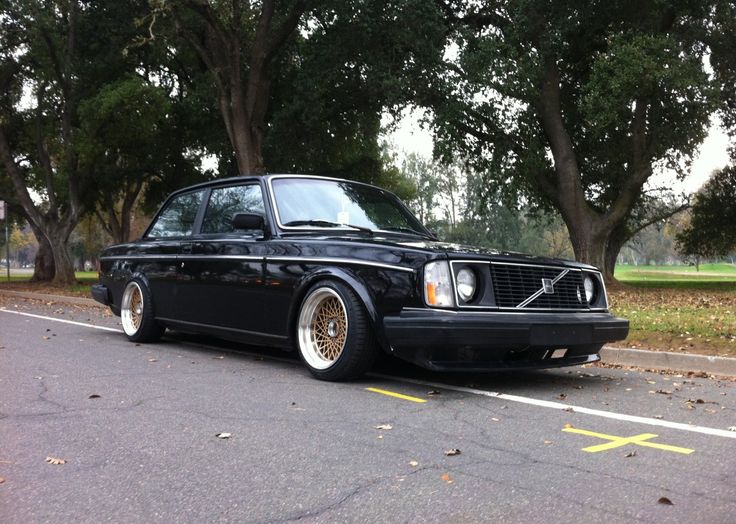

Добавить комментарий